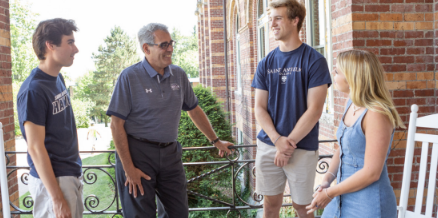College president Joseph Favazza has presented the college community with a plan for the college he calls “Vision 2030.” Favazza has begun explaining the goals of this initiative at Faculty Senate meetings and at a town hall event he hosted last month. The changes are inspired by an economic trend predicted to happen, starting in 2026, and a goal to improve St. A’s structure.
In his own words, Dr. Favazza described Vision 2030 as an attempt to imagine what the college will look like in the next seven years. Dr. Favazza described the process as a strategic plan. The Vision starts with changes being made for 2025. With the help of the Board of Trustees, Dr. Favazza is preparing the college for the long term, and the forces shaping higher education.
According to the Faculty Senate minutes, these changes include establishing and completing the new School of Nursing and Health Sciences. The goal for 2025 is also to accomplish the “The near completion of a new Track & Field facility with fully recruited men and women teams (75 students)”, renovation of Dominic and Joan of Arc Halls, and the establishment of the Office of Partnerships.
“What do we need to do in order to make Saint Anselm even stronger academically, financially; in every way, so that our enrollment stays strong…so that we don’t, in any way, put the college at risk,” Favazza said.
Dr. Favazza also spoke on the Track and Field team, which was recently added to the varsity roster. The field should be started over the summer, according to Dr. Favazza, and he hopes that it will be a turf field for soccer, lacrosse, and other sports. Track and Field, one of the largest sports in high school applicants, is going to be a potential recruitment offer added by Vision 2030.
Last year, a Diversity, Equity, and Inclusion plan was launched, aiming for a more inclusive campus. The plan includes raising money for scholarships, and Dr. Favazza hopes more will come as Vision 2030 develops.
The Vision also implemented Anselmian Journeys, a signature program of the 2030 goals. The new program is being piloted this year for first-year students. Anselmian Journeys will integrate elements of Conversatio and conversations of career. The program was designed to allow first-year students access to resources and career decision support.
Vision 2030 also includes “financial stewardship.” According to Dr. Favazza, it’s a pillar of managing resources as Vision 2030 continues. Dr. Favazza has worked with the Conference and Events team to expand new revenue sources. This revenue would be non-academic; conferences, camps over the summer, and other strategies for getting people on campus. The financial stewardship pillar of Vision 2030 also includes looking into new properties beyond campus and including solar panels for utilities.
A piece of Vision 2030 is the enhancement of the college’s graduate and undergraduate programs. Vision 2030 hopes to attract new students with more programs offered. New programs being made available were designed to address the predicted slide in demographic admission rates over the next decade. Dr. Favazza admitted that the demographics could be a challenge to the school. Vision 2030 is the preparation plan.
As mentioned in the Town Hall, Dr. Favazza mentioned the plan to establish the “schools.” The current school, the School of Nursing and Health Sciences would be joined by the
School of Business, Economics, and Ethics, and the School of Arts and Sciences. The goal of the change would be to increase the visibility of majors that are struggling with enrollment. There will be fluidity among the three schools, students wouldn’t be bound by the school they selected, and other majors and minors could be selected from a different school.
Within the Faculty Senate minutes examine the details Vision 2030 has in keeping the values and traditions of St. A’s. The conclusion of the Vision 2030 proposal states, “Vision 2030 imagines the future of the college as radically analogical and integrative. We will both fundamentally remain who we have been for our 140-plus years of existence and change to meet the challenges of the 21st century.”
Dr. Favazza commented on the balancing act of looking for expansion and growth, for the well-being of the college, while also maintaining the values that make St. A’s unique. Vision 2030 is rooted in Saint Anselm’s Catholic and Benedictine identity. Dr. Favazza reaffirmed that Vision 2030 is what the college must become to achieve its priorities.“We can’t just rely on our reputation and our past; we have to do some new things as well, in order to meet the future,” he said.
Dr. Favazza added, “I want to tell alumni that we haven’t changed at all, that we’re still the same Saint Anselm when they came here…but on the other hand; we’re not the same, we’re trying to be innovative…but not at the expense of our mission.” Although revisions are being made to the curriculum, Dr. Favazza confirmed that he is looking to keep Theology and Philosophy at the core. Addressing concerns of the student body, Dr. Favazza is open to having more Town Halls, even monthly. Dr. Favazza has received feedback from the board, faculty, monastery, and students, which he hopes continues, as The Vision 2030 becomes a reality.


